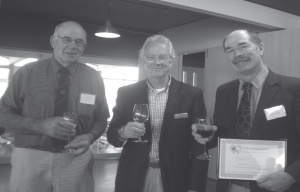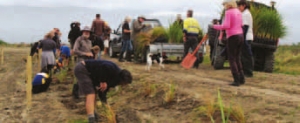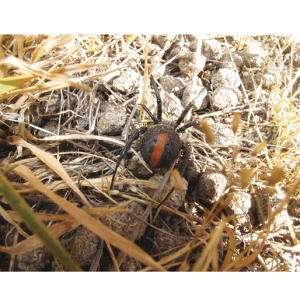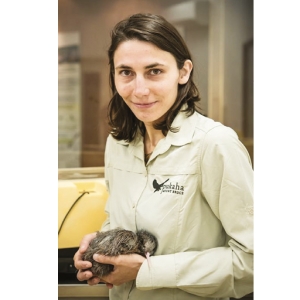Super User
From the President
From the
President
Spring is here again and the wetlands are bursting into life with fresh plant growth and increasing breeding activity among the birds.
This was well illustrated recently when I visited James and Jane Hunter’s property at Porangahau, Central Hawke’s Bay. They are DU members and recently received a grant from DU Wetland Care Trust to assist with the construction of a complex of five dams along a swampy gully. Passionate wetland conservationists; they typify what DU is about.
This on-going interest from private landowners and support from DU is vital for wetlands and waterfowl. Read more about their achievements elsewhere in this issue.
John Cheyne
Wetland Impresses
The Wairio Wetlands were on the list for the 200 members of the New Zealand Farm Forestry Association being hosted by the Wairarapa branch for their 55th annual conference.
Our own DU member and director, John Dermer is currently their national president. Wairarapa Farm Forestry president Stu Orme, and secretary Shane Atkinson, were thoughtful enough to write to Jim Law and thank him for hosting their field trip to Wairio:
“We would like to thank you for the effort you put in to host our field trip to the Wairio wetlands. Your restoration project directly addresses all three themes of our conference and is an outstanding example of a local initiative on a grand scale. Lake Wairarapa dominates the whole of the lower valley and the re-creation of wetlands along the degraded eastern boundary is a task with very long-term benefits. All our visitors enjoyed their trip. Thank you again.”
John Dermer said that all 200 of the NZFF conference attendees visited Wairio.
“We visited Castle Point Station in the north and down to the southern end to Prinoa Station and Waiorongomai on our last day with a look at Wairio and a talk from Jim Law.”
John said that once again he was struck by the sheer size of the Wairio Wetland although it was living up to its name, 'dry water' at the time. “Jim told us about the weed issues, mainly tall fescue, which makes getting trees established more difficult and the answers we are trying to find. One thing I noticed was how well plants are managing on the piles of soil excavated, so my main question is Why not do more? “There must be a shallow water table underneath so why aren’t we digging deeper? “What is the point of digging holes so shallow they don’t hold water?” John said there is no way he would site his maimai on this bit of dry wetland. He said he is sure the Farm Foresters were impressed, and they certainly asked lots of questions.
John Dermer
Nikau Foundation grant for Wairio Wetland
A cheque for $6500 from the Nikau Foundation was handed over to Ducks Unlimited (DUNZ) President Ross Cottle and Patron Jim Campbell by Gus van de Roer of the Nikau Foundation to go towards the restoration of the Wairio Wetland.
Nikau Foundation Chairman Kevin O’Connor said he was delighted the Foundation was able to support Ducks Unlimited with its restoration work at the Wairio Wetland on the eastern shore of Lake Wairarapa.
While most grants had previously gone to Wellington based organisations he added that the Wairarapa is part of the wider community supported by the Foundation.
Ross Cottle said the grant would go towards site preparation and tree planting at the joint venture project with DOC.
“We are starting to see the results of four years of effort and this injection of funds will help maintain the momentum of the project,” said Ross.
Tree planting is planned for May/June and volunteers are welcome. In past years children from Pirinoa Primary School, students from the Taratahi Agricultural Training Centre, Rotarians and DU and F&B members have assisted with the planting.
Nikau Foundation is the community foundation for the Wellington region, part of a worldwide family that provides a simple, effective and long-lasting way for people to leave a gift for causes close to their heart and close to home. Because the capital is invested and only the income is given out, the gift
keeps on giving forever.
The grant for the Wairio Wetland restoration project has been arranged by Nikau on behalf of the Richard and Doreen Evans Trust.
Wetland vegetation focus of examination
The Wario Wetland has come in for some close scrutiny by Victoria University Student Bridget Johnson who is this year studying towards an MSc in Ecological Restoration. The overall title of her thesis is “Ecological restoration of the Wairio Wetlands, Lake Wairarapa: vegetation dynamics and succession”.
A Summer Scholarship meant she was able to do 10 weeks of research in her chosen field at Wario with the title for that part of her research being “Temporal & Spatial Patterns of Wetland Vegetation during the Summer Desiccation Period at Wairio Wetlands, Wairarapa”. In addition to the summer scholarship, Bridget has started preparing a second site at Wairio for a large scale experimental project where around 2400 trees have been planted.
The summer study programme provided an introduction to the Wairio Wetland for Bridget where she continues the research for her thesis on factors contributing to wetland restoration. Flight, with help from Jim Law, has been able to follow Bridget’s research so far.
A poster she produced she said was just a snap shot of some of that research. “Due to the limiting size of the poster, I only talked about rare species vulnerability.” All the summer scholars got to show their posters at a poster evening. Her poster included the following information plus a number of illustrations.
Introduction
Small in size, New Zealand’s native wetlands plant species are repeatedly outcompeted by more aggressive weeds. The surrounding vegetation invades when wetland plants are most vulnerable, during the desiccation (dry) period. A number of threatened low-lying plants (Pratia and Glosso) inhabit the Wairio Wetlands. To conserve these native plants a greater understanding is required of their optimal conditions and their spatial and temporal dynamics. “My aim was to investigate the temporal scale of the native species, and which abiotic factors affect their spatial distribution.”
Methods
Vegetation composition was sampled in 20 quadrants over a 10 week summer period. The quadrants were set five metres apart along two 50 metre perpendicular transects. The first transect followed a moisture gradient, whilst the other ran parallel. Additional abiotic variables were measured, such as soil moisture, soil pH, percentage open ground, sunshine hours and rainfall. Water Plantain was chosen as a comparative species as it is a common invader and an indicator of high soil moisture.
Discussion
The rare species are restricted to a small band of high moisture sites. A smaller number of invasive species can grow in these moist soils, so there are fewer competitors for the natives. In drier soils, the invasive species can spread easily, giving the vulnerable natives little chance of survival. This means the natives have truly specialised ecological requirements, as their time frame of existence and habitat preference is small. This is a contributing factor to what makes them vulnerable. Further research can be expanded from this study, for example: Should water plantain (and other invasive high moisture soil species) be managed to decrease the competition on the native species? Illustrations on the poster included Glasso, Pratia and Water plantain. Glosso and Pratia grow in soil with high moisture content and Water plantain grows more abundantly in high moisture soil but is adaptable to a greater variance of soil moisture. Bridget said the native species emerge later in the summer season, whereas water plantain is a consistent species. When the natives start emerging they have a higher percentage cover than the invasive water plantain.
“I would like to thank Dr Stephen Hartley, Tony Silbery (Department of Conservation Wairarapa), Jim Law (Ducks Unlimited) and Don Bell (Greater Wellington Regional Council) for their technical support,” said Bridget.
References: New Zealand Plant Conservation. 2010.
Enthusiasm and hard work for restoration
During the last weeks of June, a band of enthusiastic Wairio Wetland members and other helpers were involved in more planting at the wetland.
The Wairio Wetland Restoration Committee met back in May and agreed the last two weeks of June would be planting time and Don Bell (GWRC) would be requested to check on Warren Field's (DOC schools Co-ordinator), availability was well as the GWRC BBQ team. Attendees were expected to be two local primary schools (Pirinoa & Kahutara), plus South Featherston and Martinborough, students from Taratahi Agricultural Training College, Rotarians, DU members & others (eg F & B members).
Jim submitted a claim for an agreed payment by Rotary for the costs of the signage at stage 1 ($450). Additionally he made a further application to rotary for the cost of weed mats ($2200). both were approved by Rotary.
Bridget Johnson, the Masters student from the School of Biological Science at Victoria University was onsite supervising the digger scraping of planting test plots.
The purchasing of trees and other materials has progressed with assistance from Don bell, Trevor Thompson (EQII) and Tony Silbery (DOC). Specialist and consistent tree planting skills are required to ensure the integrity of the research programme.
The budget for this years programme agreed at the previous meeting and additional costing data that became available as agreed is as follows:
- Earthmoving (scraping planting plots at stage 3 and lagoon site at stage 2) $2500 - Fencing (repairs to stage 1) $500
- Spot Spraying (stage 3 prior to planting) $2,000
- Weed mats (stage 3) $2,500
- Plants (stage 3) $5,000
- Noxious weed spraying (stage 3 prior to planting and maintenance at stage 1 and 2) $1,000
- Release spraying (stages 1, 2, and 3 in late spring 2011 and late summer 2012) $2,500
In Previous meetings it was agreed that a budget of $2500 should be ear-marked, subject to further fund-raising and commitment by DU for resources for additional plantings in two small fenced off areas north of stage 3. An audit of their suitability for additional planting by Don, Trevor and Tony would also be required and it was hoped this could be scheduled over the next few months.
Think Big Discussion
Based on feedback from recent visitors to the wetland (Farm Forestry and DU groups), as well as growing confidence within the Committee that significant progress is being made, the possibility ofa major planting to complete stages 1, 2 and 3 in the next few years was discussed.
There was agreement in principle to this approach and as a first step an estimate should be madeof the planting required in eash stage. It is also agreed that at the same time estimates be made of what areas not suitable for planting could be bulldozed to create significant lagoons. Financial costings would be then prepared as well as estimated manpower requirements to complete the work.
Research Award
Recently over 25 supporters of the Wairio Wetland Restoration Project came together to plant over 2,000 sedges,flaxes, nurse trees and specimen trees.
After being welcomed to the site and reminded by Jim Law of Ducks Unlimited of the Vision to restore the pristine wetland that had previously occupied the site, and after being briefed on the preferred planting technique by Don Bell of the Greater Wellington Regional Council the planting teams then
heard from Bridget Johnson, a Masters student from Victoria University’s Centre for Biodiversity & Restoration Ecology. Bridget’s thesis is focused on restoration work at Wairio and will compare tree survival rates and costs related to different site preparation methods and subsequent maintenance treatments. “That’s why we need the consistent planting technique, otherwise we introduce another rather random variable” said Bridget.
“The whole idea of the research programme is to introduce some scientific rigour to our restoration work” said Jim Law. “We all have our favourite ways of planting and caring for native trees but there is little, if any, science to back up what we do. Dr Hartley, Bridget’s supervisor added “We expect the results of Bridget’s research and the results from future students working at Wairio will be applicable elsewhere around the Lake and at least in the wider Wairarapa”.
So, well briefed on the Vision, planting techniques and the importance of the research programme the planting teams comprising students from the Taratahi Agricultural Training Centre, Ducks Unlimited, Forest & Bird and Rotary members, local iwi and both Department of Conservation and Greater Wellington staff headed off to plant various combinations of nurse and specimen trees in the test beds.
Then the “A” teams arrived, the environmentalists of the future from the Pirinoa, Kahutara and Martinborough Primary Schools. After being similarly greeted and briefed on planting techniques the children all headed off with their minders to plant sedges and flaxes in some soft ground near the water’s edge. “They love it and are proud of what they are doing. They also want to see further development of the wetland” said Steve Davis from Pirinoa.
Then, when the children had finished their planting, it was back to the BBQ provided by Greater Wellington Regional Council for a well learnt sausage! “Tired but happy with what they have achieved” was the consensus. The older planters also had a break at the BBQ but then had to head back to the test beds for more planting but, by the end of the day over 2,000 plants were carefully planted.
“A great effort by all!” said a thankful Bridget.
Endangered native beetle
Endangered native beetle threatened by rabbits and redbacks
An “unholy alliance” between rabbits and Australian redback spiders is threatening the existence of an endangered New Zealand species, a study by AgResearch has shown.
Carried out with the Department of Conservation (DOC) and University of Otago, the study has illustrated the struggle for the ongoing survival of the Cromwell chafer beetle – a nationally endangered native species that can now only be found in the 81 hectare Cromwell Chafer Beetle Nature Reserve between Cromwell and Bannockburn, in Central Otago.
The study found numerous rabbit holes that shelter the rabbits were also proving ideal spaces for the redback spiders to establish their webs. Investigation of those webs in the rabbit holes found the Cromwell chafer beetle was the second-most commonly found prey of the spiders.
“Of course the rabbits and spiders aren’t actually plotting to bring about the demise of the chafer beetle, but these findings do give a fascinating insight into the almost accidental relationships that can develop between species in the natural world, and how that can impact on other species,” said AgResearch Principal Scientist Dr Barbara Barratt.
“Otago University students doing research in the area found that 99 percent of the spiders had built their webs in the rabbit holes. We don’t know exactly how many of the chafer beetles there are left because they are not easy to find, but research into larval densities tells us the numbers are low. It does appear the redback spider, which has established populations in two locations in New Zealand since the 1980s, has been increasing in number over time, and this increases the risks for the beetle population.
“What we were able to show in our research was that filling in those rabbit holes was an effective way of eliminating the presence of the redback spiders at the treated sites, and therefore reducing the rate of the chafer beetle being preyed upon.
”As a result of the research, DOC has carried out a programme to break down old rabbit holes and hummocks in the reserve to destroy spider nests, and also does regular rabbit control. An annual survey for beetle larvae with AgResearch will show whether these actions are having an effect.
“We will survey for beetle larvae next summer to see what effect reducing redback spider nests is having on the Cromwell chafer beetle,” said DOC Ecology Technical Advisor Bruce McKinlay. “Hopefully we’ll find the beetle population has increased with fewer falling prey to this introduced venomous spider.”
The Cromwell chafer beetle (Prodontria lewisi) is a large flightless beetle that lives underground in the sandy soils of the Cromwell river terrace. In spring and summer adult beetles emerge from the ground at night to feed on plants and to breed.
Jarrod Booker
AgResearch External Communications Manager
Makeover at Matuku Link.
It links the Ark in the Park
Habitat te Henga; and the Forest & Bird reserve, Matuku so we called our newly purchased property, Matuku Link. Some of you may have helped our GiveaLittle appeal to purchase it and we took possession on November 1st late last year.
There are 37 hectares with three or four of those being alluvial flats including several scattered dock and buttercup ridden paddocks, irregularly divided by old riverbed meanders. In the meanders is a mix of tree lined open water with emergent baumea, extended raupo and swamp millet beds and carex, cyperus and juncus sedge patches. Peppered on the flats are remnant pukatea, kahikatea, kaikomako and totara.
Wasting no time, we held several working bees. Several truckloads of junk were taken away, scrap iron to the metal merchant, and the house made liveable for our new resident caretaker. A boundary line of poplar was felled and about a hectare of blackberry sprayed.
All internal fences were removed with the help of an obliging neighbour and the posts set aside for some future use – which manifested a mere month later. A group of 30 students from the Culver Academy, Indiana, touring through New Zealand wanted to be part of a conservation project. With a labour force that big, and four magnificent local carpenters, we constructed in two days 40 metres of boardwalk over a stream outlet on the Matuku Reserve.
Carrying tools, timber and a large generator almost a kilometre along the riverbank to the site, these energetic teens and their tutors helped finish a project that had been on the to-do list for four years. Some of them also helped plant kahikatea, the first of many trees, shrubs and sedges that will convert the paddocks to an alluvial forest resembling that which once existed. Other intrepid travellers had arrived the week before and, unfortunately, their arrival coincided with Auckland’s mid March weather bomb. With the river some 3-4m higher than usual, turbulent and silt laden, the never-saydie elvers (young eels) all the way from Tonga were seen flick flacking over the flooded bridge.
The desire to enable this property, which has easy access, to become a site for a wetland education centre has also rocketed ahead. The Trusts Community Fund Million Dollar Mission was opened on March 1 with several selected community groups competing to get votes from supporters for their projects. By the time the million ran out, Matuku Link had gained over 17,000 votes with each vote worth $5. The money will go toward material needed for the conversion of the barn while design and build will be a real=life project for Unitec students from the schools of survey, architecture landscape, and construction.
John Sumich
Matuku Link trustee
MB100 – a milestone for Pukaha
MB100 – a milestone for Pukaha
Pukaha was delighted to announce the 100th kiwi chick to be hatched in the nursery since it started hatching kiwi chicks under human care in September 2005 MB100 made its way into the world on March 18, 2017. Lead kiwi ranger, Jess Flamy, was on hand to assist. Jess has supervised the hatch of nine kiwi at Pukaha this year so MB100 was in very safe hands!
To celebrate the 100 milestone hatch, Pukaha held a Kids Go Free day in March when MB100 was having one of its first feeds at 12 noon.
Pateke – clutch No. 3
More conservation breeding success with the hatch of five more pateke ducklings in the Free Flight Aviary. This is the third clutch for the same pateke pair this year so they must be pretty happy in their new home. Mum is fairly happy showing off her new brood and at 4pm daily there is a ranger talk in the Free Flight Aviary and the pateke are usually happy to eat the mealworm treats they get at that time on their pond.
DOC does its bit
Kea set free after successful leg surgery
A young kea has been released back into the wild in Fiordland after his severely injured leg was successfully remodelled by vets. Thanks to Real Journeys, Air New Zealand and Meridian Energy for being involved in this happy ending.
Rare native buttercup found on Stewart Island
The mount Allen buttercup was found by DOC botanists on a remote mountain range on Stewart Island/Rakiura. The island is a hotspot for endemic plants with at least 28 native plants, many of them alpine species, found there.
Motley Crew arrive in Hawke’s Bay
Kōrure (mottled petrels) have been translocated from Whenua Hou (Codfish Island) to their new home at Maungaharuru. These translocations gave 67 birds a new home and are part of an effort to restore seabird populations.
New science links to China will benefit NZ
AgResearch intends to form a joint international research centre with China’s largest state–owned food company and largest university research department specialising in food science and nutrition.
A Collaboration Arrangement was signed earlier this year in Beijing with the Nutrition and Health Research Institute (NHRI) within the China Oils and Foodstuffs Corporation (COFCO), and with the College of Food Science and Nutritional Engineering (CFSNE) of China Agriculture University (CAU).
The parties will explore opportunities to work together formally in the name of a “Joint International Research Centre for Food Science’ to promote international exchange, research and productivity, with a particular focus on further enhancing a China/New Zealand relationship”.
The arrangement states: “The overall goal of the collaboration is to initiate activities that are of mutual benefit to the parties in terms of knowledge development, scientific and technological innovation and economic benefit”.
AgResearch chief executive Tom Richardson says the relationship with such influential institutions – from the world’s most populous country with a rapidly expanding middle class – opens up a host of opportunities for AgResearch, and agriculture and agribusiness in New Zealand.
“We are fortunate to have world-class scientists in New Zealand. Being able to reach out and work with some of the best scientists elsewhere in the world bolsters what we are doing, and what we can offer to enhance industry here.”
“Some of the key research areas where AgResearch expects to work closely with COFCO and CAU are food science, processing, food assurance and safety, and human nutrition.”
For those seeking further information, email This email address is being protected from spambots. You need JavaScript enabled to view it. or contact:
Jarrod Booker, External Communications Manager, AgResearch Ltd.
03 321 8612
021 832 351







